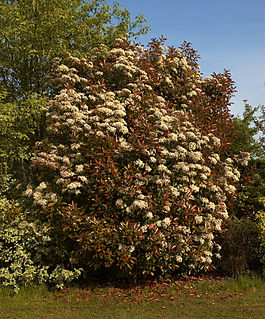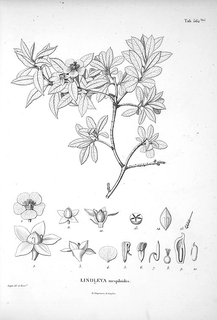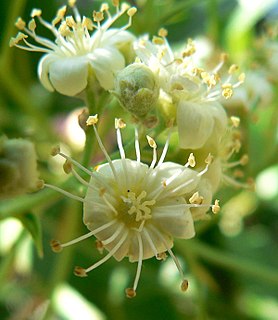The MaloideaeC.Weber was the apple subfamily, a grouping used by some taxonomists within the rose family, Rosaceae. Recent molecular phylogenetic evidence has shown that the traditional Spiraeoideae and Amygdaloideae form part of the same clade as the traditional Maloideae, and the correct name for this group is Amygdaloideae. Earlier circumscriptions of Maloideae are more-or-less equivalent to subtribe Malinae or to tribe Maleae. The group includes a number of plants bearing commercially important fruits, such as apples and pears, while others are cultivated as ornamentals.

Amygdaloideae is a subfamily within the flowering plant family Rosaceae. It was formerly considered by some authors to be separate from Rosaceae, and the family names Prunaceae and Amygdalaceae have been used. Reanalysis from 2007 has shown that the previous definition of subfamily Spiraeoideae was paraphyletic. To solve this problem, a larger subfamily was defined that includes the former Amygdaloideae, Spiraeoideae, and Maloideae. This subfamily, however, is to be called Amygdaloideae rather than Spiraeoideae under the International Code of Nomenclature for algae, fungi, and plants as updated in 2011.
The subfamily Spiraeoideae was traditionally a subfamily of flowering plants within the family Rosaceae. The taxonomy of this subfamily has changed several times in the last century as more detailed studies have been carried out. Spiraeoideae as defined before 2007 is paraphyletic, leading some authors to define a broader subfamily which includes the Spiraeoideae as well as the Maleae, and the Amygdaloideae. Such an expanded subfamily is to be called Amygdaloideae under the International Code of Nomenclature for algae, fungi, and plants.

Sorbus is a genus of about 100–200 species of trees and shrubs in the rose family, Rosaceae. Species of Sorbus (s.l.) are commonly known as whitebeam, rowan, service tree, and mountain-ash. The exact number of species is disputed depending on the circumscription of the genus, and also due to the number of apomictic microspecies, which some treat as distinct species, but others group in a smaller number of variable species. Recent treatments treat Sorbus in a narrower sense to include only the pinnate leaved species of subgenus Sorbus, raising several of the other subgenera to generic rank.

Aronia is a genus of deciduous shrubs, the chokeberries, in the family Rosaceae native to eastern North America and most commonly found in wet woods and swamps. The genus is usually considered to contain two or three species, one of which is naturalized in Europe. A fourth form that has long been cultivated under the name Aronia is now considered to be an intergeneric hybrid, × Sorbaronia mitschurinii.

Cercocarpus, commonly known as mountain mahogany, is a small genus of at least nine species of nitrogen-fixing flowering plants in the rose family, Rosaceae. They are native to the western United States and northern Mexico, where they grow in chaparral and semidesert habitats and climates, often at high altitudes. Several are found in the California chaparral and woodlands ecoregion.

Photinia is a genus of about 40–60 species of small trees and large shrubs, but the taxonomy has recently varied greatly, with the genera Heteromeles, Stranvaesia and Aronia sometimes included in Photinia.

Stranvaesia is a genus of flowering plants in the family Rosaceae. Its morphology is so similar to Photinia that it has sometimes been included within that genus, but recent molecular data indicate that the two genera are not related.

Pseudocydonia sinensis or Chinese quince is a deciduous or semi-evergreen tree in the family Rosaceae, native to southern and eastern China, and the sole species in the genus Pseudocydonia. Its hard, astringent fruit is used in traditional Chinese medicine and as a food in East Asia. Trees are generally 10–18 metres (33–59 ft) tall.

Holodiscus is a genus of flowering plants in the family Rosaceae, native to the Americas, from southwestern British Columbia, Canada and the western United States south to Bolivia.

Neillia is a genus of the botanical family Rosaceae. They are deciduous shrubs or subshrubs. They produce clusters of terminal or axillary flowers, and have dry dehiscent fruits. They are found exclusively in eastern and central Asia.

Gillenia is a genus of two species of perennial herbs in the family Rosaceae. Common names for plants in this genus include: Bowman's root, Indian-physic, American ipecac. This genus is endemic to dry open woods with acidic soils in eastern North America. Both plants are subshrubs with exposed semi-woody branches and serrated leaves; the larger lower leaves are divided into palmately arranged leaflets. Plants bloom in May, June, or July; blooms are composed of five slender white petals which are loosely arranged and typically appear slightly twisted and limp as if they were wilted. The flowers mature into small capsules. These plants are often planted as ornamentals and used in herbal medicine.

Kageneckia is a genus of flowering plant in family Rosaceae.

Chamaebatiaria is a monotypic genus of aromatic shrub in the rose family containing the single species Chamaebatiaria millefolium, which is known by the common names fern bush and desert sweet. Its genus name comes from its physical resemblance to the mountain miseries of genus Chamaebatia, which are not closely related. This is a hairy, sticky plant covered in fernlike foliage made up of fronds of small leaflets. At the ends of the erect branches of this spreading bush are inflorescences of white roselike flowers. This shrub is a resident of scrub, woodland, and forests in western North America. The closest relative of Spiraeanthus.

Lindleya is a genus of Mexican evergreen trees of the family Rosaceae. The sole species, L. mespiloides, grows to a height of 6 metres (20 ft) and bears solitary white fragrant flowers in summer. The fruit are dry dehiscent capsules.

Neillieae is a tribe of flowering plants in rose family and the Amygdaloideae subfamily. It includes the genera Physocarpus and Neillia.

Malacomeles, or false serviceberry, is a genus of flowering plants in the Rosaceae. It is most closely related to Amelanchier, Peraphyllum, Crataegus, and Mespilus.

Vauquelinia californica, commonly known as Arizona rosewood, is an evergreen species of shrub or tree, in the rose family, Rosaceae.

The Maleae are the apple tribe in the rose family, Rosaceae. The group includes a number of plants bearing commercially important fruits, such as apples and pears, while others are cultivated as ornamentals. Older taxonomies separated some of this group as tribe Crataegeae, as the Cydonia group, or some genera were placed in family Quillajaceae.

Malinae is the name for the apple subtribe in the rose family, Rosaceae. This name is required by the International Code of Nomenclature for algae, fungi, and plants, which came into force in 2011 for any group at the subtribe rank that includes the genus Malus but not either of the genera Rosa or Amygdalus. The group includes a number of plants bearing commercially important fruits, such as apples and pears, while others are cultivated as ornamentals.


















